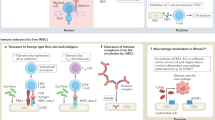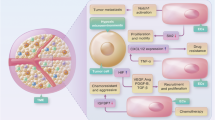Abstract
Endothelial cell activation in the process of tumor angiogenesis and in various aspects of vascular biology has been extensively studied. However, endothelial cells also function in other capacities, including in immune regulation. Compared to the more traditional immune regulatory populations (Th1, Th2, Treg, etc.), endothelial cells have received far less credit as being immune regulators. Their regulatory capacity is multifaceted. They are critical in both limiting and facilitating the trafficking of various immune cell populations, including T cells and dendritic cells, out of the vasculature and into tissue. They also can be induced to stimulate immune reactivity or to be immune inhibitory. In each of these parameters (trafficking, immune stimulation and immune inhibition), their role can be physiological, whereby they have an active role in maintaining health. Alternatively, their role can be pathological, whereby they contribute to disease. In theory, endothelial cells are in an ideal location to recruit cells that can mediate immune reactivity to tumor tissue. Furthermore, they can activate the immune cells as they transmigrate across the endothelium into the tumor. However, what is seen is the absence of these protective effects of endothelial cells and, instead, the endothelial cells succumb to the defense mechanisms of the tumor, resulting in their acquisition of a tumor-protective role. To understand the immune regulatory potential of endothelial cells in protecting the host versus the tumor, it is useful to better understand the other circumstances in which endothelial cells modulate immune reactivities. Which of the multitude of immune regulatory roles that endothelial cells can take on seems to rely on the type of stimulus that they are encountering. It also depends on the extent to which they can be manipulated by potential dangers to succumb and contribute toward attack on the host. This review will explore the physiological and pathological roles of endothelial cells as they regulate immune trafficking, immune stimulation and immune inhibition in a variety of conditions and will then apply this information to their role in the tumor environment. Strategies to harness the immune regulatory potential of endothelial cells are starting to emerge in the non-tumor setting. Results from such efforts are expected to be applicable to being able to skew endothelial cells from having a tumor-protective role to a host-protective role.




Similar content being viewed by others
References
Wilhelmsen K, Mesa KR, Prakash A, Xu F, Hellman J (2012) Activation of endothelial TLR2 by bacterial lipoprotein upregulates proteins specific for the neutrophil response. Innate Immun 18:602–616
Salsman VS, Chow KK, Shaffer DR et al (2011) Crosstalk between medulloblastoma cells and endothelium triggers a strong chemotactic signal recruiting T lymphocytes to the tumor microenvironment. PLoS ONE 6:e20267
Johnson LA, Jackson DG (2010) Inflammation-induced secretion of CCL21 in lymphatic endothelium is a key regulator of integrin-mediated dendritic cell transmigration. Int Immunol 22:839–849
Bao X, Moseman EA, Saito H et al (2010) Endothelial heparan sulfate controls chemokine presentation in recruitment of lymphocytes and dendritic cells to lymph nodes. Immunity 33:817–829
Chyou S, Benahmed F, Chen J, Kumar V, Tian S, Lipp M, Lu TT (2011) Coordinated regulation of lymph node vascular-stromal growth first by CD11c+ cells and then by T and B cells. J Immunol 187:5558–5567
Sage PT, Varghese LM, Martinelli R, Sciuto TE, Kamei M, Dvorak AM, Springer TA, Sharpe AH, Carman CV (2012) Antigen recognition is facilitated by invadosome-like protrusions formed by memory/effector T cells. J Immunol 188:3686–3699
Robertson J, Lang S, Lambert PA, Martin PE (2010) Peptidoglycan derived from Staphylococcus epidermidis induces Connexin43 hemichannel activity with consequences on the innate immune response in endothelial cells. Biochem J 432:133–143
Wang W, Deng M, Liu X, Ai W, Tang Q, Hu J (2011) TLR4 activation induces nontolerant inflammatory response in endothelial cells. Inflammation 34:509–518
Teijaro JR, Walsh KB, Cahalan S et al (2011) Endothelial cells are central orchestrators of cytokine amplification during influenza virus infection. Cell 146:980–991
Dalrymple NA, Mackow ER (2012) Endothelial cells elicit immune-enhancing responses to dengue virus infection. J Virol 86:6408–6415
Huertas A, Tu L, Gambaryan N et al. (2012) Leptin and regulatory T lymphocytes in idiopathic pulmonary arterial hypertension. Eur Respir J [Epub ahead of print]
Maganto-Garcia E, Bu DX, Tarrio ML et al (2011) Foxp3+-inducible regulatory T cells suppress endothelial activation and leukocyte recruitment. J Immunol 187:3521–3529
Johansson AS, Johansson-Haque K, Okret S, Palmblad J (2008) Ethyl pyruvate modulates acute inflammatory reactions in human endothelial cells in relation to the NF-κB pathway. Br J Pharmacol 154:1318–1326
Konya V, Ullen A, Kampitsch N et al. (2012) Endothelial E-type prostanoid 4 receptors promote barrier function and inhibit neutrophil trafficking. J Allergy Clin Immunol [Epub ahead of print]
Pittet CL, Newcombe J, Prat A, Arbour N (2011) Human brain endothelial cells endeavor to immunoregulate CD8 T cells via PD-1 ligand expression in multiple sclerosis. J Neuroinflammation 8:155
Weiss R, Lifshitz V, Frenkel D (2011) TGF-β1 affects endothelial cell interaction with macrophages and T cells leading to the development of cerebrovascular amyloidosis. Brain Behav Immun 25:1017–1024
Fu H, Khan A, Coe D, Zaher S, Chai JG, Kropf P, Muller I, Larkin DF, George AJ (2011) Arginine depletion as a mechanism for the immune privilege of corneal allografts. Eur J Immunol 41:2997–3005
Sugita S, Kawazoe Y, Yamada Y, Imai A, Horie S, Yamagami S, Mochizuki M (2012) Inhibitory effect of corneal endothelial cells on IL-17-producing Th17 cells. Br J Ophthalmol 96:293–299
Bublitz DC, Noah CE, Benach JL, Furie MB (2010) Francisella tularensis suppresses the proinflammatory response of endothelial cells via the endothelial protein C receptor. J Immunol 185:1124–1131
Fritzsche C, Schleicher U, Bogdan C (2010) Endothelial nitric oxide synthase limits the inflammatory response in mouse cutaneous leishmaniasis. Immunobiology 215:826–832
Norder M, Gutierrez MG, Zicari S, Cervi E, Caruso A, Guzman CA (2012) Lymph node-derived lymphatic endothelial cells express functional costimulatory molecules and impair dendritic cell-induced allogenic T-cell proliferation. FASEB J 26:2835–2846
Cruz D, Wang Z, Kibbie J, Modlin R, Kwon O (2011) Diversity through phosphine catalysis identifies octahydro-1,6-naphthyridin-4-ones as activators of endothelium-driven immunity. Proc Natl Acad Sci USA 108:6769–6774
Delfortrie S, Pinte S, Mattot V et al (2011) Egfl7 promotes tumor escape from immunity by repressing endothelial cell activation. Cancer Res 71:7176–7186
Arteta B, Lasuen N, Lopategi A, Sveinbjornsson B, Smedsrod B, Vidal-Vanaclocha F (2010) Colon carcinoma cell interaction with liver sinusoidal endothelium inhibits organ-specific antitumor immunity through interleukin-1-induced mannose receptor in mice. Hepatology 51:2172–2182
Hochst B, Schildberg FA, Bottcher J et al. (2012) Liver sinusoidal endothelial cells contribute to CD8+ T cell tolerance towards circulating carcinoembryonic antigen in mice. Hepatology [Epub ahead of print]
Zang X, Sullivan PS, Soslow RA et al (2010) Tumor associated endothelial expression of B7-H3 predicts survival in ovarian carcinomas. Mod Pathol 23:1104–1112
Brunner A, Hinterholzer S, Riss P, Heinze G, Brustmann H (2012) Immunoexpression of B7-H3 in endometrial cancer: relation to tumor T-cell infiltration and prognosis. Gynecol Oncol 124:105–111
Casos K, Siguero L, Fernandez-Figueras MT, Leon X, Sarda MP, Vila L, Camacho M (2011) Tumor cells induce COX-2 and mPGES-1 expression in microvascular endothelial cells mainly by means of IL-1 receptor activation. Microvasc Res 81:261–268
Mulligan JK, Young MR (2010) Tumors induce the formation of suppressor endothelial cells in vivo. Cancer Immunol Immunother 59:267–277
Mulligan JK, Day TA, Gillespie MB, Rosenzweig SA, Young MR (2009) Secretion of vascular endothelial growth factor by oral squamous cell carcinoma cells skews endothelial cells to suppress T-cell functions. Hum Immunol 70:375–382
Mulligan JK, Lathers DM, Young MR (2008) Tumors skew endothelial cells to disrupt NK cell, T cell and macrophage functions. Cancer Immunol Immunother 57:951–961
Mulligan JK, Rosenzweig SA, Young MR (2010) Tumor secretion of VEGF induces endothelial cells to suppress T cell functions through the production of PGE2. J Immunother 33:126–135
Baratelli F, Lin Y, Zhu L et al (2005) Prostaglandin E2 induces FOXP3 gene expression and T regulatory cell function in human CD4+ T cells. J Immunol 175:1483–1490
Bao YS, Zhang P, Xie RJ, Wang M, Wang ZY, Zhou Z, Zhai WJ, Feng SZ, Han MZ (2011) The regulation of CD4+ T cell immune responses toward Th2 cell development by prostaglandin E2. Int Immunopharmacol 11:1599–1605
Hinz B, Brune K, Pahl A (2000) Prostaglandin E2 upregulates cyclooxygenase-2 expression in lipopolysaccharide-stimulated RAW 264.7 macrophages. Biochem Biophys Res Commun 272:744–748
Vivaldi A, Ciampi R, Tacito A, Molinaro E, Agate L, Bottici V, Pinchera A, Collecchi P, Elisei R (2012) Celecoxib, a cyclooxygenase-2 inhibitor, potentiates the chemotherapic effect of vinorelbine in the medullary thyroid cancer TT cell line. Mol Cell Endocrinol 355:41–48
Bocca C, Bozzo F, Cannito S, Parola M, Miglietta A (2011) Celecoxib inactivates epithelial-mesenchymal transition stimulated by hypoxia and/or epidermal growth factor in colon cancer cells. Mol Carcinog 10. doi:10.1002/mc.20846
Sharma V, Dixit D, Ghosh S, Sen E (2011) COX-2 regulates the proliferation of glioma stem like cells. Neurochem Int 59:567–571
Acknowledgments
This work was supported by the Department of Veterans Affairs through a Clinical Sciences Research & Development award (CX000100) and a Senior Research Career Scientist award, and by grants RO1 CA128837 and RO1 DE018268 from the National Institutes of Health.
Conflict of interest
The author declares that she has no conflict of interest.
Author information
Authors and Affiliations
Corresponding author
Rights and permissions
About this article
Cite this article
Young, M.R. Endothelial cells in the eyes of an immunologist. Cancer Immunol Immunother 61, 1609–1616 (2012). https://doi.org/10.1007/s00262-012-1335-0
Received:
Accepted:
Published:
Issue Date:
DOI: https://doi.org/10.1007/s00262-012-1335-0




